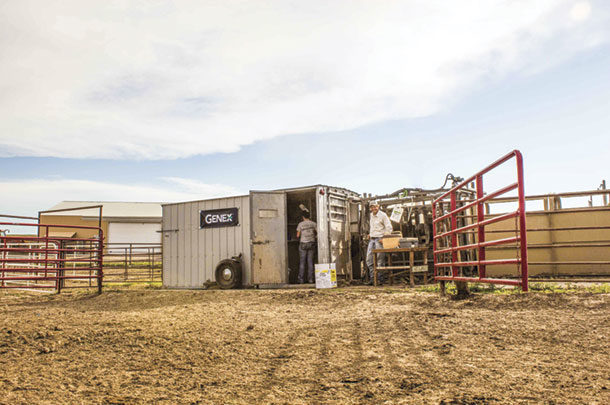Reproductive technologies such as artificial insemination (A.I.) and estrous synchronization (ES) can provide measurable value in the right situation – but often are dismissed as too complicated or logistically challenging to employ.
For producers tapping into A.I., accessing high-quality, targeted genetics is often the main driver, says Sarah Thorson, beef marketing manager at Genex. Buying young bulls at auction can be a challenge, as prospects have a level of accuracy in their expected progeny differences (EPDs) but not to the extent of highly proven bulls with confirmed traits supported by data.
“The option of using the best sires to help reach individual herd goals becomes available. It provides an opportunity for making genetic improvements and decisions that help drive the bottom line on the ranch. Most commercial or registered operators aren’t going to pay 50,000, 60,000 or 100,000 dollars for bulls on a regular basis, even though it’s not uncommon for them to sell at those prices. With A.I., these same genetics are accessible for 20 or 25 dollars.”
Breeding strategies can be fine-tuned by selecting proven maternal sires for replacement females and terminal sires with established track records of feedlot performance for cows targeting the growth- and carcass-dominated finishing markets.
Thorson believes having this kind of information creates extensive value and adding estrous synchronization protocols to top-shelf genetics delivers even more bang for the buck.
By shortening the breeding season, the calving period is tightened as well, producing more calves born earlier, leading to heavier weights at weaning.
“The season is condensed, more uniformity is gained, plus bigger and more efficient calves are generated. Fewer sorts are needed when they sell on the internet auction or at the sale barn.”
Jump-starting the process
Pursuing superior genetics may be the most popular reason A.I. is used, but one of the biggest advantages of synchronization is how it impacts reproductive performance, says Cliff Lamb, department head for animal science and professor in reproductive biology at Texas A&M University.
“A portion of heifers won’t have attained puberty, and a percentage of cows won’t have reinitiated their cycle when breeding season approaches. The ES hormones stimulate those females to begin cycling again. This bunches up animals but also initiates non-cycling animals to get pregnant at the beginning of the breeding season.”
Lamb believes with cattle cycling and observed in estrus, 60% to 65% conception rates are achievable and realistic if quality semen is used by skilled technicians. This rate will match females exposed to bulls with natural service in the pasture.
He agrees adding ES to A.I. increases the odds of pregnancy, as the variability of heat detection can be removed from the equation. Even the best detectors will only catch a percentage of a group and, with similar conception rates, overall pregnancy rates will be lower.
With ES prompting non-cycling cows into heat and using timed A.I. without detection, the entire group is inseminated. While the resulting conception rate will be slightly lower, the pregnancy rate will be higher because all females are synchronized.
He says that, on average, after calving cows will take 30 to 100 days before they begin coming back into heat. “It’s important to know the desired outcome of the system. If the pregnancy rate is of highest concern, then waiting 45 to 50 days after calving to synchronize is a good strategy because a greater percentage will be cycling when inseminated.”
Lamb explains cows between 21 and 50 days post-calving benefit the most from synchronization, as they are less likely to be cycling but can be stimulated and become pregnant sooner. He stresses producers need to understand they might have slightly lower pregnancy rates, possibly 45% instead of the 55% of timed A.I., but they will gain from accelerating them to become pregnant sooner.
Putting the logistics problem on wheels
While a lack of on-site pasture facilities, insufficient chutes, headgates or weather-proofing services on the ranch site might have been an acceptable reason to avoid ES and A.I. in the past, today resources are in place to strike through these logistical concerns, according to the University of Missouri Extension Livestock Service.
 Beef extension services and many reproductive facility providers supply single- or double-stalled portable trailer barns to transport to scattered work sites. Photo courtesy of Missouri Extension Services.
Beef extension services and many reproductive facility providers supply single- or double-stalled portable trailer barns to transport to scattered work sites. Photo courtesy of Missouri Extension Services.
They, along with other beef extension services and many reproductive facility providers, supply single- or double-stalled portable trailer barns which are easily transported to scattered work sites. From a facility management standpoint, a catch pen and small portable alleyway in a pasture or space to position the trailer at the home site infrastructure is all that’s needed.
A small hydraulic pump lowers the trailer barn to ground level after wheel blocks are removed. When the work is completed, it’s lifted, wheel blocks are replaced, and it’s ready for the next job.
Rentals with or without qualified ES and A.I. staff are possible. Two workers completing the breeding and a third thawing semen and preparing the A.I. catheter is optimal staffing for most tasks. With minimal portable fencing, 30 to 40 head can be bred per hour.
Cattle enter through a sliding back door and are directed to a stall using a lockable swinging middle gate. A pulled cable drops a bar behind, keeping the animal in position and minimizing the risk of being kicked. Heads are in relative darkness behind a rubber curtain, helping maintain calm. The two-stall design also limits stress as animals stand side by side.
The spacious trailers are open to the ground, so cattle walk on a natural surface. After A.I. is complete, simply pulling a cable opens the front door to allow a quiet exit.
Most are wired for either 12-volt or 110 power so only an extension cord run to a nearby power source or a generator is required to run a thaw unit and basic lights.
Logistical challenges should never hinder the use of reproductive technologies such as ES and A.I. in today’s beef industry. Too much is at stake to ignore the benefits of superior genetics, controlled labor, stimulation of non-cycling females and higher conception and pregnancy rates.












